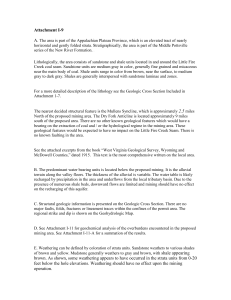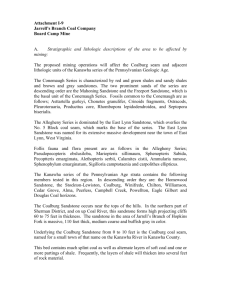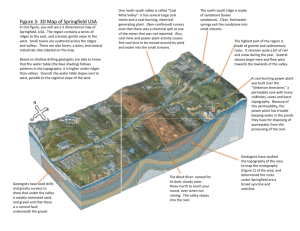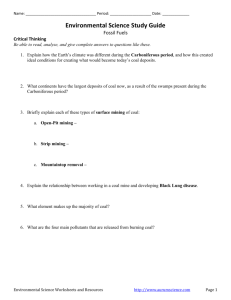Attachment I-9
advertisement
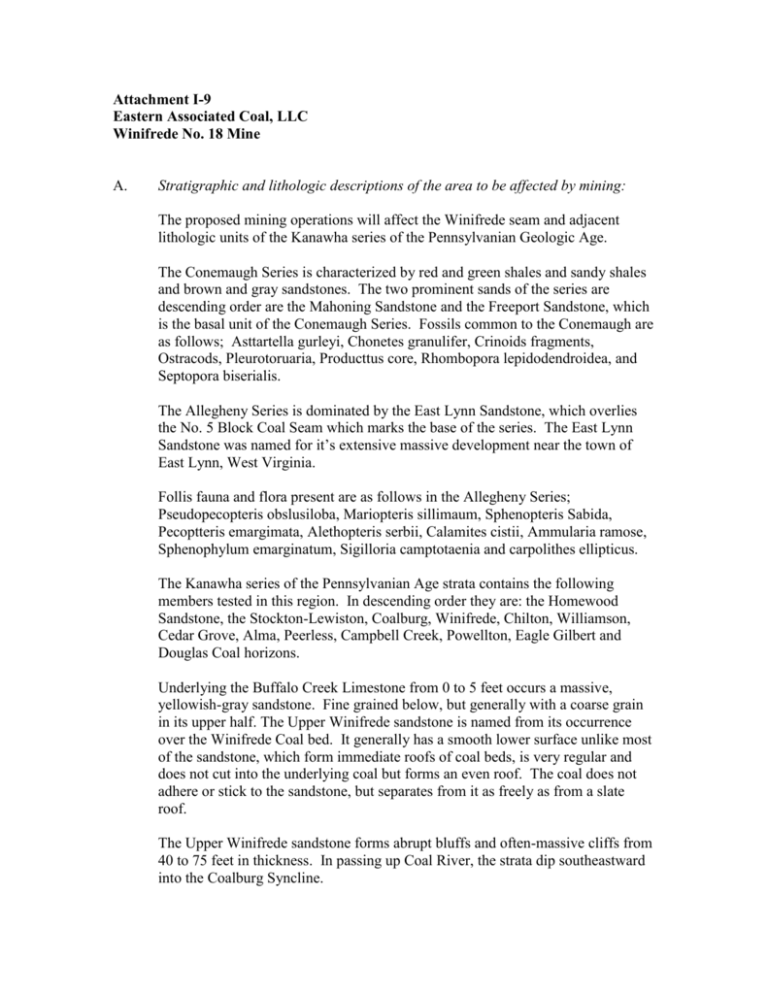
Attachment I-9 Eastern Associated Coal, LLC Winifrede No. 18 Mine A. Stratigraphic and lithologic descriptions of the area to be affected by mining: The proposed mining operations will affect the Winifrede seam and adjacent lithologic units of the Kanawha series of the Pennsylvanian Geologic Age. The Conemaugh Series is characterized by red and green shales and sandy shales and brown and gray sandstones. The two prominent sands of the series are descending order are the Mahoning Sandstone and the Freeport Sandstone, which is the basal unit of the Conemaugh Series. Fossils common to the Conemaugh are as follows; Asttartella gurleyi, Chonetes granulifer, Crinoids fragments, Ostracods, Pleurotoruaria, Producttus core, Rhombopora lepidodendroidea, and Septopora biserialis. The Allegheny Series is dominated by the East Lynn Sandstone, which overlies the No. 5 Block Coal Seam which marks the base of the series. The East Lynn Sandstone was named for it’s extensive massive development near the town of East Lynn, West Virginia. Follis fauna and flora present are as follows in the Allegheny Series; Pseudopecopteris obslusiloba, Mariopteris sillimaum, Sphenopteris Sabida, Pecoptteris emargimata, Alethopteris serbii, Calamites cistii, Ammularia ramose, Sphenophylum emarginatum, Sigilloria camptotaenia and carpolithes ellipticus. The Kanawha series of the Pennsylvanian Age strata contains the following members tested in this region. In descending order they are: the Homewood Sandstone, the Stockton-Lewiston, Coalburg, Winifrede, Chilton, Williamson, Cedar Grove, Alma, Peerless, Campbell Creek, Powellton, Eagle Gilbert and Douglas Coal horizons. Underlying the Buffalo Creek Limestone from 0 to 5 feet occurs a massive, yellowish-gray sandstone. Fine grained below, but generally with a coarse grain in its upper half. The Upper Winifrede sandstone is named from its occurrence over the Winifrede Coal bed. It generally has a smooth lower surface unlike most of the sandstone, which form immediate roofs of coal beds, is very regular and does not cut into the underlying coal but forms an even roof. The coal does not adhere or stick to the sandstone, but separates from it as freely as from a slate roof. The Upper Winifrede sandstone forms abrupt bluffs and often-massive cliffs from 40 to 75 feet in thickness. In passing up Coal River, the strata dip southeastward into the Coalburg Syncline. Attachment I-9 Eastern Associated Coal, LLC Winifrede No. 18 Mine Underlying the Upper Winifrede sandstone, from 0 to 10 feet, is one of the most important coals in the Kanawha Series. It is a multiple bedded, hard, splinty coal with some layers of block coal which render it very desirable for domestic fuel and steam purposes. This bed was named the Winifrede Coal from a mining village of that name on Fields Creek in Kanawha County, 15 miles south of Charleston, where the coal was first mined for commercial purposes as early as 1855. The Winifrede Coal is one of the most important beds in Crook District, being of commercial thickness and purity in nearly the whole district. In the northern part of the district, the coal is high on the hills, but dips rapidly through the Coalburg Syncline. Underneath the Winifrede Coal, and separated from the same by impure fire clay and sandy shale from 2 to 5 feet, there occurs a bed of massive, gray sandstone that has been named the Lower Winifrede. This bed is often split up into several members of shale and sandstone, and it ranges in thickness from 20 to 40 feet. This sandstone bed appears to be different in texture and lithological aspects from sandstone overlying the coal marks the lower portion of the Upper Kanawha series. This stratum rises above the beds of the streams in the northern part of Boone County, and is generally massive, forming cliffs along its outcrop. B. Hydrogeologic setting including the areal and vertical distribution of all aquifers; seasonal differences in head; the name(s) of the stratum (or strata) in which the water is found; and the availability, movement, quality, and quantity of ground water flow in all aquifer units: There are no known present users of aquifers within the proposed permit area. The nearest known available source of ground water is from deeps well located in the communities of Wharton and Twilight. The wells located near Wharton are located at structure33, 34, 35, 48 and 49. However the water supplies for structure 48 and 49 were replaced by a previous permit, due to low flow and contamination The wells located at Twilight are located at structure 63 shared by 64 and 66. Other wells are located at structure 65, 82, 94, 95 and 108. Any wells used for domestic ground water supply are a minimum of 300 feet lower in elevation than the seam to be mined. Because the proposed mine is stratigraphically higher than the aquifer which is used locally as a source for ground water supplies, no dilution or interruption of local ground or surface water availability is anticipated. Water is available in both areas from West Virginia American Water Company. Attachment I-9 Eastern Associated Coal, LLC Winifrede No. 18 Mine C. Structural geology of the coal seam and strata to be affected by mining both in the Permit and adjacent areas, including faults, folds, fracture and lineament traces, and Regional and site specific strike and dip; A core description for drill holes are listed in Attachment I-10, no faults, fold, fractures and lineament traces have been identified during exploration. See Proposal and Drainage Map for strike and dip. Also see Attachment I-9.C, Lansat Linear Features of West Virginia. D. Geochemical character of all strata and coal to be disturbed by mining and the potential of this strata for generating acid, alkaline, or iron-laden drainage; Presented as Attachment I-10 are the geologic logs for the core holes used for this part of the permit application. Location and elevation information was presented in Attachment I-8. Sulfur forms were presented in Attachment I-1. Acid/Base accounting information is provided as Attachment I-11. Because of the locations of the proposed additional openings located down-dip from the portal areas of the mining operations, a gravity discharge is anticipated. The discharge is estimated to be 0-2 cfs, and should require no chemical or physical (sediment) treatment prior to discharge, based upon present and past water qualities on adjacent mining operations in the same seam, and the results of acid/base accounting of the overburden to be disturbed. E. Depth and degree of weathering of area strata and the effects this weathering has on the physical and geochemical properties of the overburden proposed for disturbance; No fractured strata was identified by the drillers log, and weathering was minimal and should have no adverse effects on the extraction of coal and/or the hydrologic regime. F. Effects of fracturing and weathering on the extraction of coal and hydrologic regime; Fracturing and/or weathering is very minimal and should have no adverse effects on the extraction of coal and/or the hydrologic regime. Fractures may increase ground water flow allowing water following the bedding Attachment I-9 Eastern Associated Coal, LLC Winifrede No. 18 Mine planes to pass to the underlying strata. Fractures that are not associated with pronounced faults product only a small increase in overall porosity of rocks, therefore, the effect should be insignificant. G. Anticipated impacts of all proposed and exiting operations on the geology and hydrology of the area, including impacts resulting form multiple seam mining and subsidence; It is not anticipated that the impact of the proposed operation will have a profound impact on the geology of the area primarily because extensive amount of prior mining in the coal seams within the proposed area. Multiple seam mining has been conducted in the area of the proposed permit application. The overmining in the area has been in the Dorothy and Coalburg Seams. Also the seams overlying the Coalburg seam have been surface mined. Prior underground mining has eliminated all known significant aquifers above the Winifrede Coal Seam. The majority of mining underlying the area has been in the Hernshaw, Campbells Creek (2-Gas), Powellton and Eagle Seams. In the proposed area where pillaring is proposed there is a possibility that the natural fractures in the main roof will be enhanced and these enhanced fractures will than transmit a portion of the water contained in the overlying perched aquifers downward into the void created by mining. However, this is overshadowed by the mining operation in the underlying seams, which cause any accumulations of water to be transmitted down to the void created by the mining at the Eagle Seam level. H. For underground mining operations (including auger mining) indicate whether or not there is the potential for gravity discharge(s) and the anticipated quantity and quality of the discharge(s) from each potential discharge site. For non-gravity discharge situations, indicate the potential for seepage along the outcrop barrier and the potential hydraulic head might result in the underground workings. Indicate if the potential discharge will require chemical treatment. As the mining plan, has down dip punch outs, there will be a potential for a gravity discharge. Water samples of a mine discharges from the Winifrede seam are included in Attachment J-10 of this application and identified on the Water Sample Map. The quality of this discharge falls within the guideline of the Rules and Regulations. With this gravity discharge no seepage along the outcrop is anticipated.

